Run Blocking
Power Blocking vs Zone Blocking
Power (Gap/Man) Blocking Scheme (PBS)
- Holes for RB are determined by play call
- Emphasize strength and size in offensive linemen
- Good in short yardage situations
- Each of the concepts have their own set of rules to follow for run blockers, depending on defensive alignment; more to remember/read pre-snap.
- Size of a powerful PBS Olineman can work against him in pass blocking
This blocking scheme looks to account for all defenders at the point of attack. Using pulling, trapping, misdirection, and straight ahead blocking, a hole is opened for the RB to run through. A RB in a PBS is asked to be patient to allow blocks to develop, then follow his blocks through the hole once he anticipates the hole opening up.
Zone Blocking Scheme (ZBS)
- Where a running lane appears will depend on the alignment of the defensive front and what the defensive line does post snap
- Emphasize athleticism and agility in offensive linemen
- Post snap reads are important in determining which Olineman blocks which DLineman/LB.
- Since athleticism is valued over strength, goal line/short yardage running game can suffer
ZBS Olineman always make a presnap read of whether is he 'covered' or 'uncovered'. If there is a DLman lined up across from the OLman, then that OLman is covered. If there is no DLman lined up directly across from him, then he is uncovered.
If an OLman is covered, then block that DLman in front of him. If he is uncovered, then combo block with the adjacent OLman to the playside (who is probably covered). The pair of OLmen, while engaged in a combo block, make a read to determine which of them is less engaged with the DLman being combo blocked. The OLman that is less engaged will move to the second level of run defenders, leaving his teammate to sustain the block on the DLineman.
The pre-snap situation can change post snap. An uncovered OLman during presnap, may become covered (fully engaged) postsnap if the DLman slants. This is where quick decision making between OLmen allows the play to continue with the less engaged OLman moving to the second level.
ZBS running backs are not asked to be as patient as a Power Blocking Scheme running back. ZBS RBs are one cut and go, fully committing to the decision of which gap to attack. Plays can be grouped into two concepts - Inside Zone and Outside Zone. There are many variations of those two general concepts.
There are 397 users in the forums
All22 Analysis - Coverages & Concepts
May 27, 2015 at 3:10 PM
- thl408
- Moderator
- Posts: 32,361
May 27, 2015 at 3:10 PM
- thl408
- Moderator
- Posts: 32,361
Power - Power Blocking
- Playside EMOLS blocks down (black)
- FB kickout block on run force defender
- Pull backside Guard to lead through

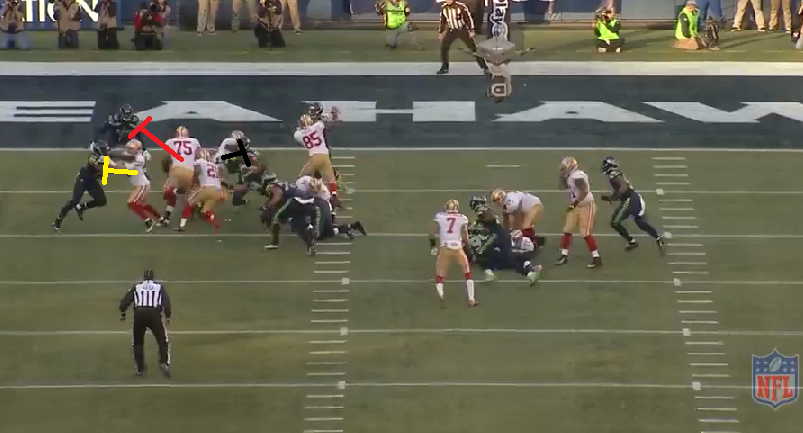
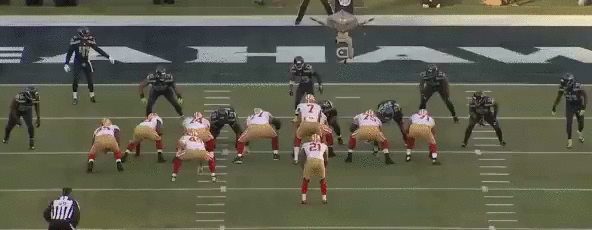
- Playside EMOLS blocks down (black)
- FB kickout block on run force defender
- Pull backside Guard to lead through



May 27, 2015 at 3:15 PM
- thl408
- Moderator
- Posts: 32,361
Counter Lead - Power Blocking
- Run to weak side of formation
- Pull strongside guard for kickout block
- Playside OT blocks down
- RB and FB take a step towards the backside of the play for misdirection
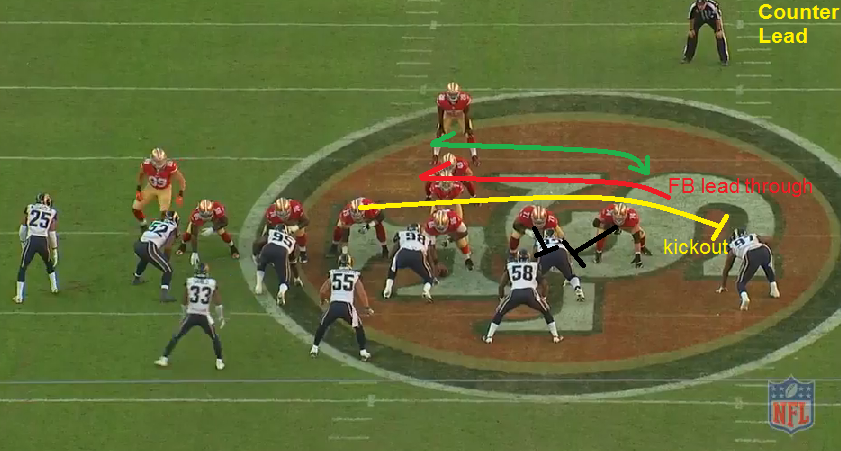
All 'Counter' action to confuse the box defenders.
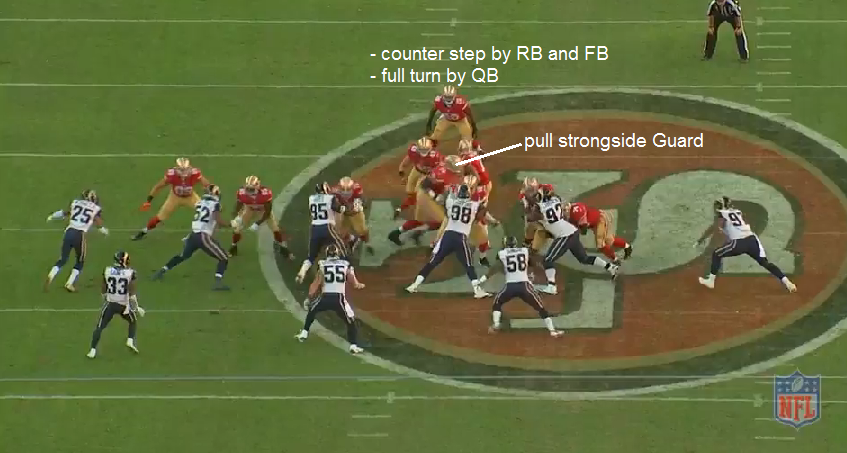
FB reads kickout block and decides to go through hole, or bounce outside.
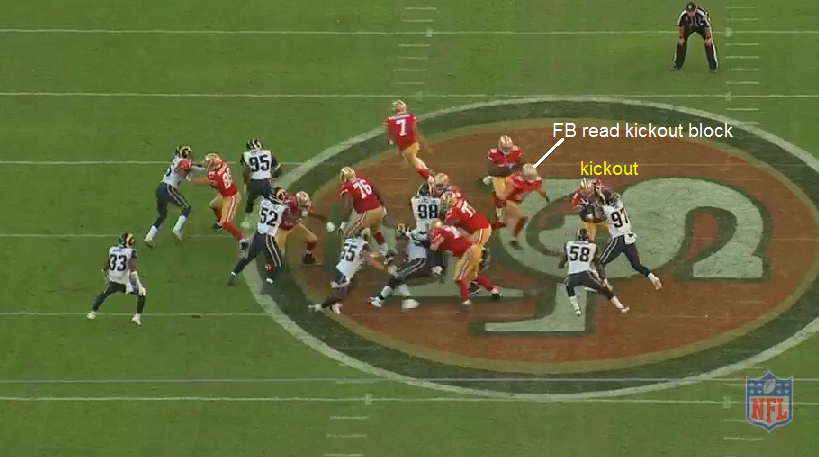

- Run to weak side of formation
- Pull strongside guard for kickout block
- Playside OT blocks down
- RB and FB take a step towards the backside of the play for misdirection

All 'Counter' action to confuse the box defenders.

FB reads kickout block and decides to go through hole, or bounce outside.


May 27, 2015 at 3:16 PM
- thl408
- Moderator
- Posts: 32,361
Guard Lead (Power Blocking)
- End man on line of scrimmage blocks down (black)
- Pull playside Guard to kickout block the run force defender (yellow)
- FB lead through the hole (red)
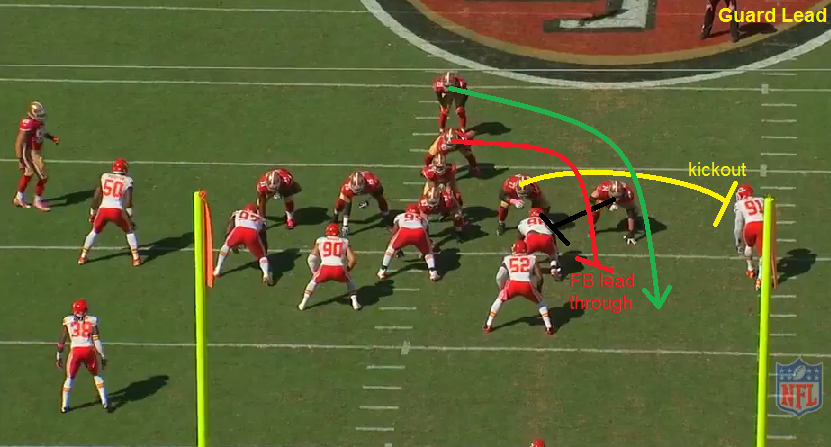
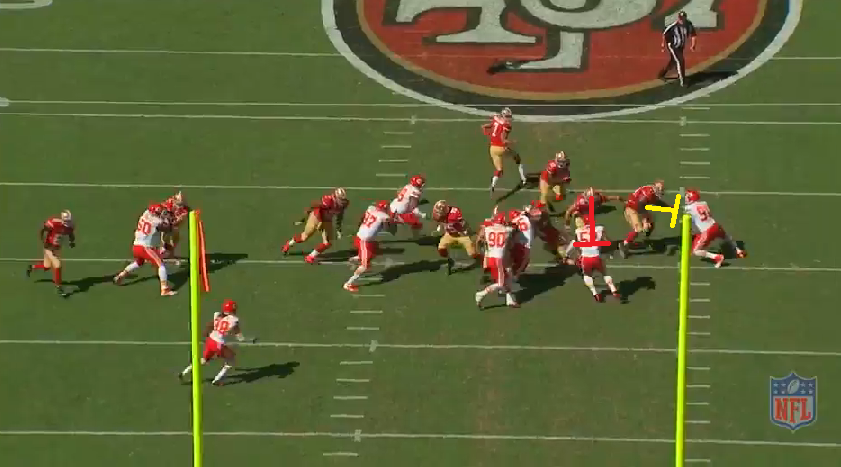
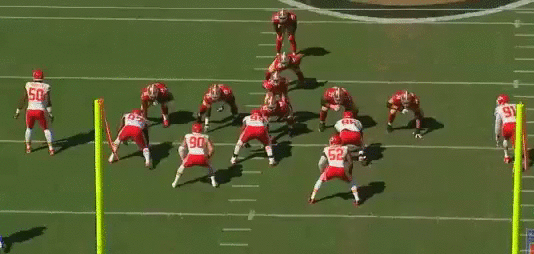
This is different from Power with the playside Guard pulling and providing the kickout block.
- End man on line of scrimmage blocks down (black)
- Pull playside Guard to kickout block the run force defender (yellow)
- FB lead through the hole (red)



This is different from Power with the playside Guard pulling and providing the kickout block.
May 27, 2015 at 3:16 PM
- thl408
- Moderator
- Posts: 32,361
Trap Block (Power Blocking)
Used to take advantage of a DLman that is aggressively trying to gain penetration (shoot a gap).
- Defender to be trapped blocked is unblocked by the OLmen lined up directly in front of him, and is allowed to cross over the line of scrimmage. This opens up an area at the targeted gap.
- A backside OLman pulls and applies the trap block
Specific play below:
- the 2-tech DT (blue) is the defender to be trap blocked .
- Right Guard in front of the 2-tech avoids the DT and moves to the second level (black)
- backside Guard pulls to apply trap block (yellow)
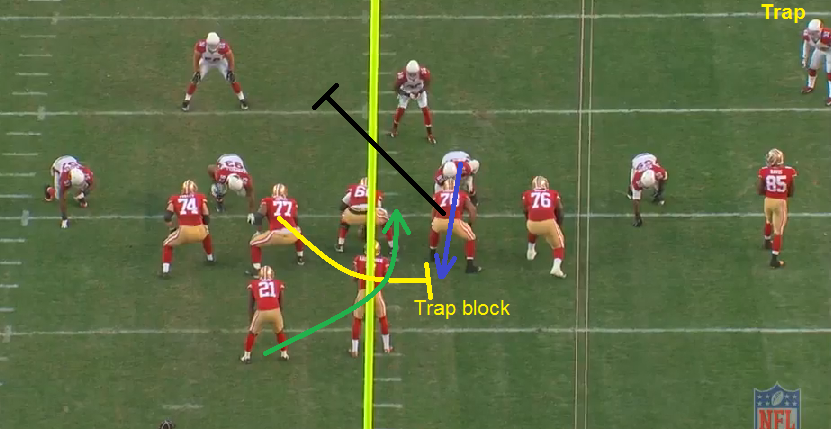
RG avoids the 2-tech. Backside guard pulls.
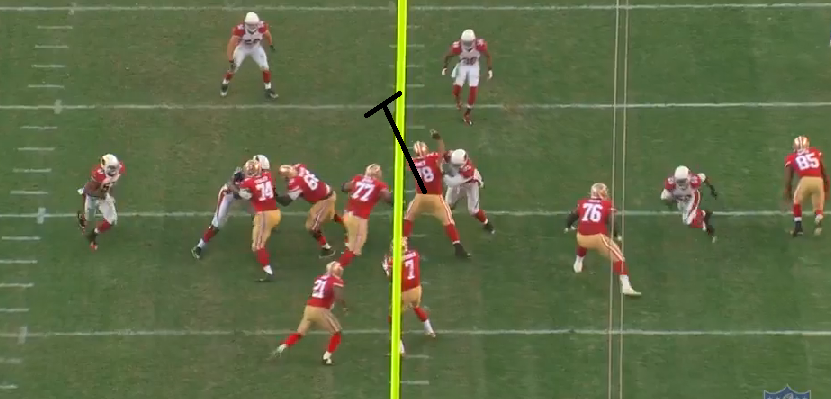
Trap blocked. The area that the trapped defender vacated is now the run lane.

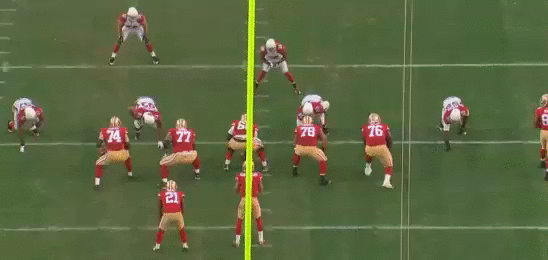
___________________________
A Wham block is just a trap block that is executed by a TE/FB (any player other than an OLineman).
Wham block by TE on the Nose Tackle.
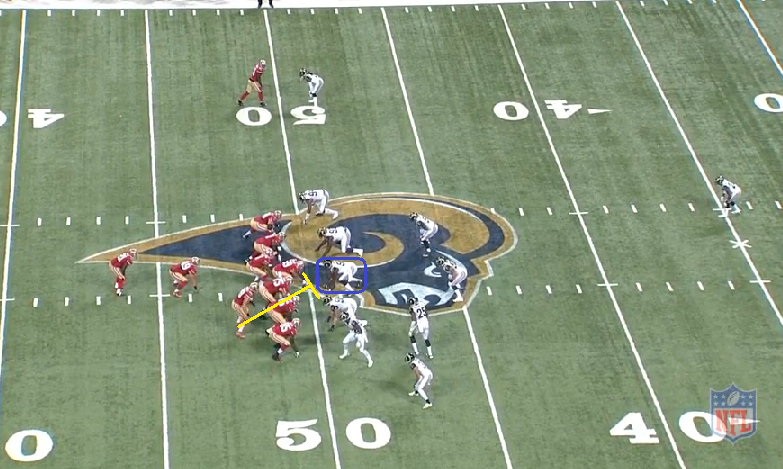
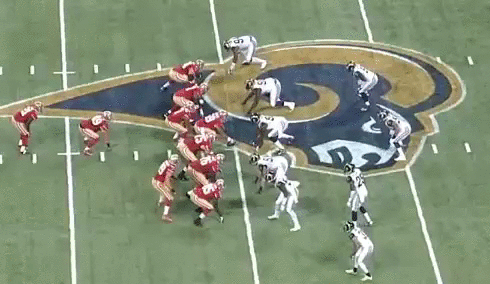
Used to take advantage of a DLman that is aggressively trying to gain penetration (shoot a gap).
- Defender to be trapped blocked is unblocked by the OLmen lined up directly in front of him, and is allowed to cross over the line of scrimmage. This opens up an area at the targeted gap.
- A backside OLman pulls and applies the trap block
Specific play below:
- the 2-tech DT (blue) is the defender to be trap blocked .
- Right Guard in front of the 2-tech avoids the DT and moves to the second level (black)
- backside Guard pulls to apply trap block (yellow)

RG avoids the 2-tech. Backside guard pulls.

Trap blocked. The area that the trapped defender vacated is now the run lane.


___________________________
A Wham block is just a trap block that is executed by a TE/FB (any player other than an OLineman).
Wham block by TE on the Nose Tackle.


May 27, 2015 at 3:16 PM
- thl408
- Moderator
- Posts: 32,361
Iso - Power Blocking
(tba)
(tba)
May 27, 2015 at 3:16 PM
- thl408
- Moderator
- Posts: 32,361
.
May 27, 2015 at 3:16 PM
- thl408
- Moderator
- Posts: 32,361
.
May 27, 2015 at 3:17 PM
- thl408
- Moderator
- Posts: 32,361
.
May 27, 2015 at 3:17 PM
- thl408
- Moderator
- Posts: 32,361
One Back Outside Zone (left) - Zone Blocking
- OL will continue to flow towards the playside
- Post snap reads and adjustments are made to determine which OLmen move to second level
Play below:
Covered: Playside TE, C, *RT
Uncovered: LT, LG, *RG
*Notice the 3-tech DT. If this was an Outside Zone Right run, then the RG is covered and the RT is uncovered due to the direction of the lateral step.
Combo blocks in red.
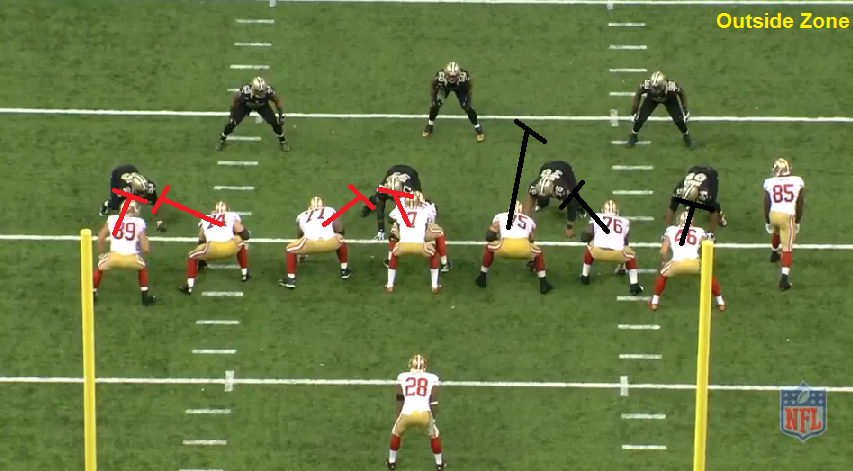
Entire OLine flows left. Combo blocks are made by the playside TE + LT, and the LG + C.
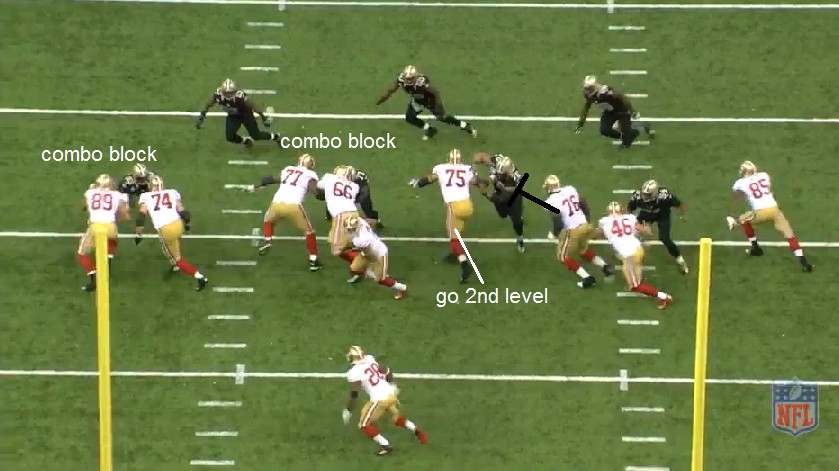
Reads are made on the fly to determine which of the four players engaged in a combo block will move to the 2nd level while which will stay to sustain the block.
The playside TE and the LG will move to the second level while the LT and C stay engaged with their blocks.
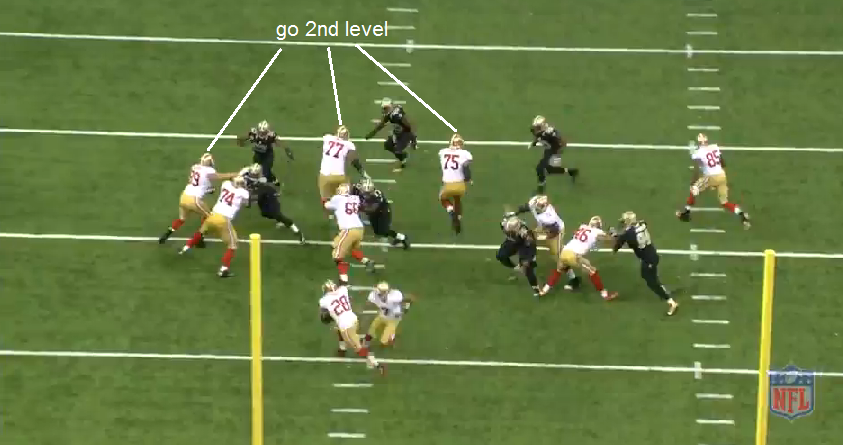
Second level blocks in yellow. RB chooses a lane and attacks it.
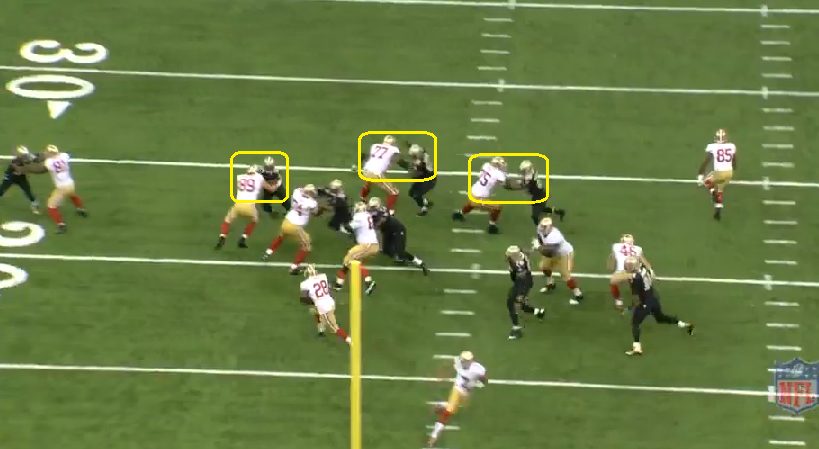

__________________________________________
Two Back Outside Zone (left) - Zone Blocking
Covered: Playside TE, LT, C, RT
Uncovered: LG, RG
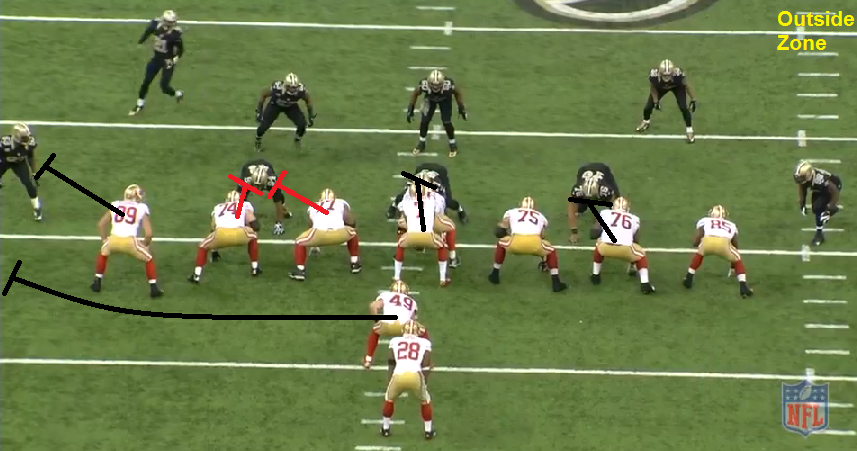
Combo blocks by LT + LG.
Backside cut block - a common ZBS technique.
The RG will not be able to reach the 2nd level and will end up pulling around - another post snap adjustment.
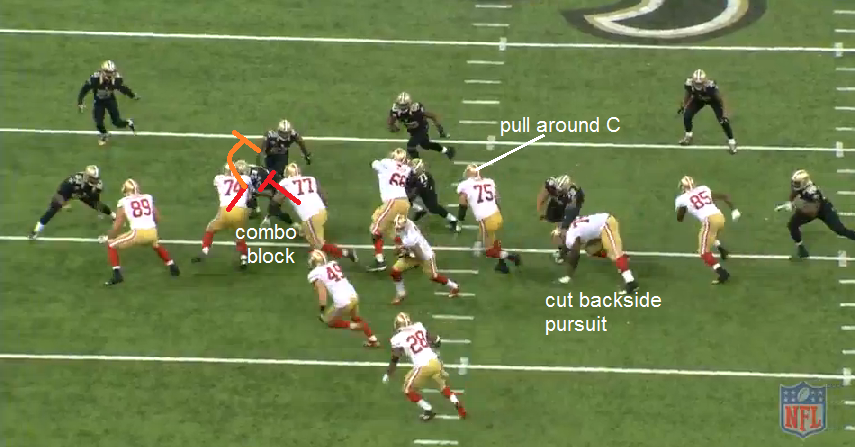
From the combo block of the LT + LG, it is decided that the LT will move on to the second level while the LG stays to sustain the block on the playside 3-tech.
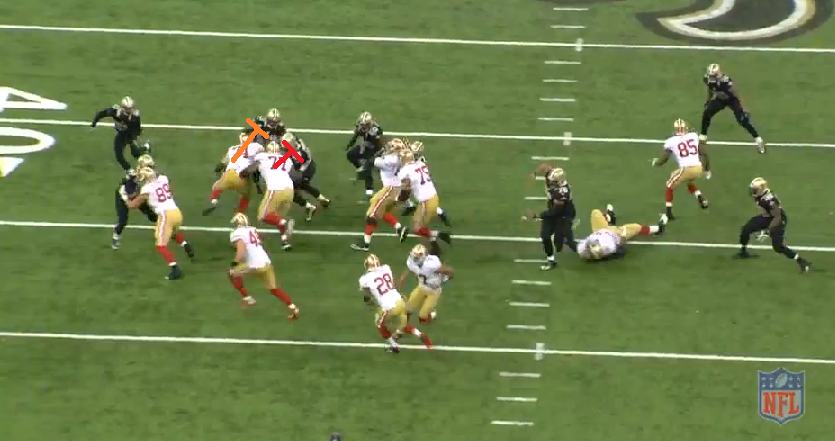
On a zone blocking play, a RB will often look for two teammate helmets next to each other. That will be the lane to run to. If there is enemy color in between any two blockers, that's not a lane to choose.
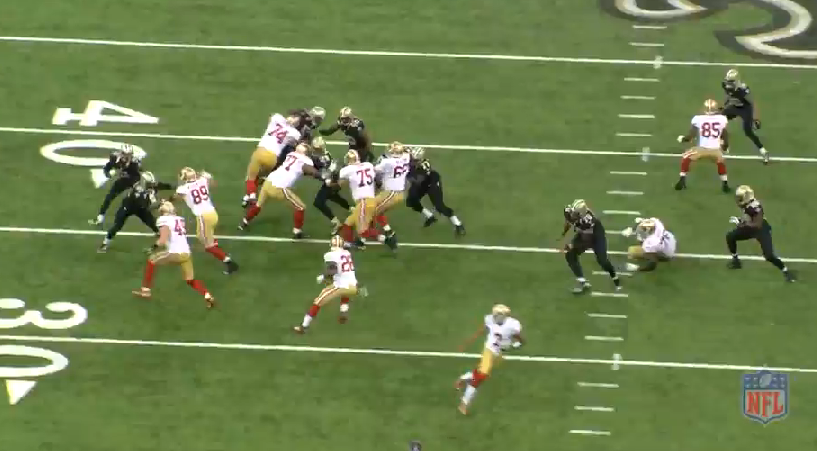

- OL will continue to flow towards the playside
- Post snap reads and adjustments are made to determine which OLmen move to second level
Play below:
Covered: Playside TE, C, *RT
Uncovered: LT, LG, *RG
*Notice the 3-tech DT. If this was an Outside Zone Right run, then the RG is covered and the RT is uncovered due to the direction of the lateral step.
Combo blocks in red.

Entire OLine flows left. Combo blocks are made by the playside TE + LT, and the LG + C.

Reads are made on the fly to determine which of the four players engaged in a combo block will move to the 2nd level while which will stay to sustain the block.
The playside TE and the LG will move to the second level while the LT and C stay engaged with their blocks.

Second level blocks in yellow. RB chooses a lane and attacks it.


__________________________________________
Two Back Outside Zone (left) - Zone Blocking
Covered: Playside TE, LT, C, RT
Uncovered: LG, RG

Combo blocks by LT + LG.
Backside cut block - a common ZBS technique.
The RG will not be able to reach the 2nd level and will end up pulling around - another post snap adjustment.

From the combo block of the LT + LG, it is decided that the LT will move on to the second level while the LG stays to sustain the block on the playside 3-tech.

On a zone blocking play, a RB will often look for two teammate helmets next to each other. That will be the lane to run to. If there is enemy color in between any two blockers, that's not a lane to choose.


May 27, 2015 at 3:17 PM
- thl408
- Moderator
- Posts: 32,361
Inside Zone - Zone Blocking
- Defenders to be combo blocked depend on the defensive alignment
- OL will take a zone step to the playside and adjust to what the defense does
Play below:
Combo blocks are shown (red).
Playside: right side of center
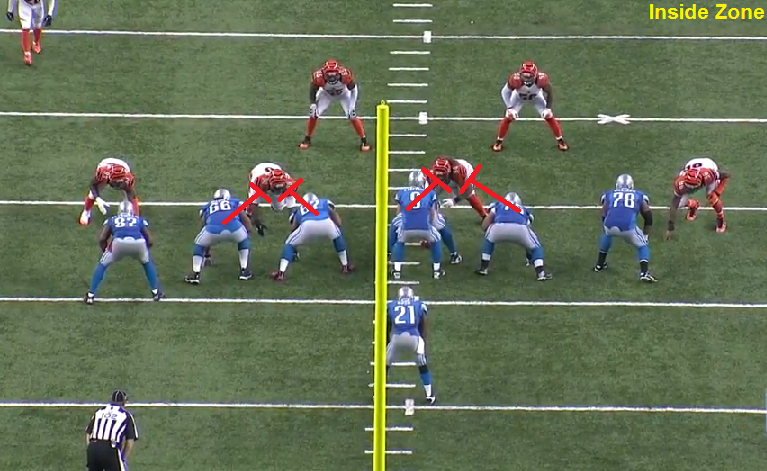
Zone step to the right. Combo blocks are made and the OLmen read the field to determine which OLmen will move to the second level. It will be the two Guards since they have the best leverage to move up and block the two LBs.
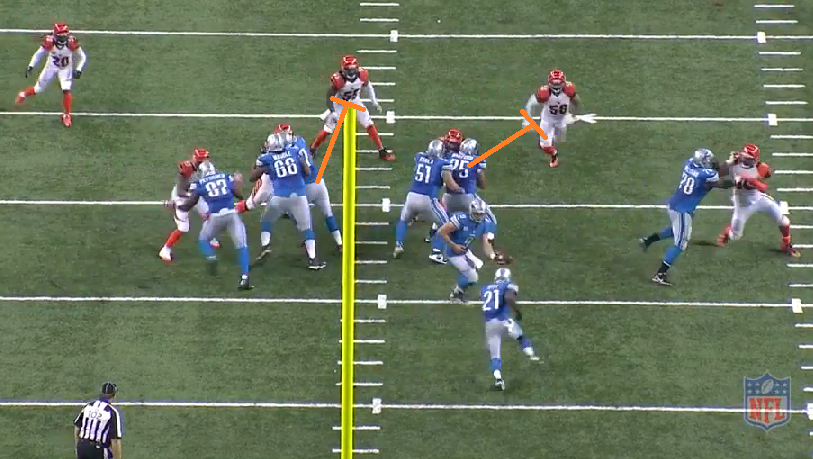
The LT and C sustain their blocks and the two Guards apply second level blocks to the LBs. RB runs to daylight.
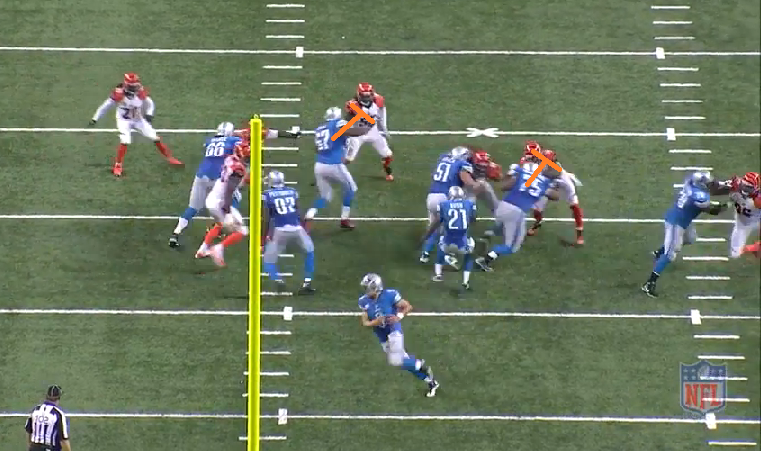
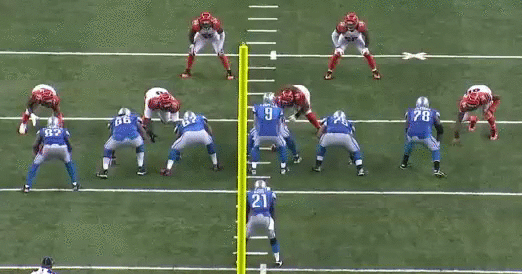
- Defenders to be combo blocked depend on the defensive alignment
- OL will take a zone step to the playside and adjust to what the defense does
Play below:
Combo blocks are shown (red).
Playside: right side of center

Zone step to the right. Combo blocks are made and the OLmen read the field to determine which OLmen will move to the second level. It will be the two Guards since they have the best leverage to move up and block the two LBs.

The LT and C sustain their blocks and the two Guards apply second level blocks to the LBs. RB runs to daylight.


May 27, 2015 at 3:17 PM
- thl408
- Moderator
- Posts: 32,361
Split Zone - Zone Blocking
- Zone step towards the strong side of the formation
- TE/FB comes across the formation to kickout block the backside cut defender.
'Covered' OLmen's blocks are black. Kickout block is yellow.
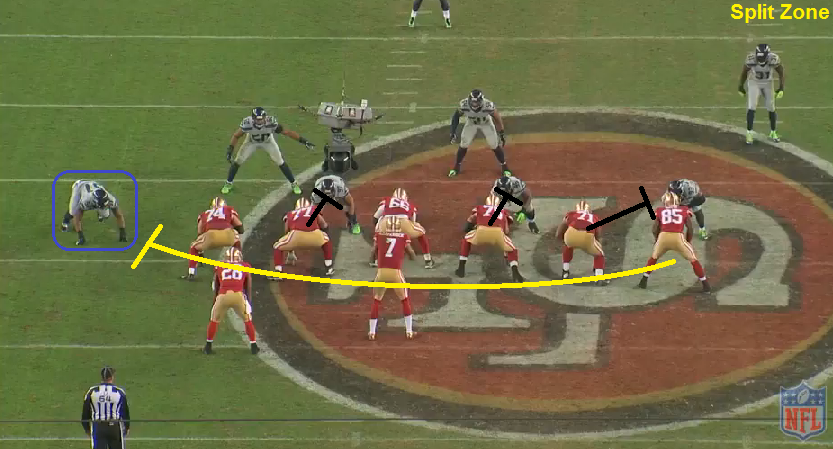
Uncovered OLmen move to second level as TE comes across the formation, opposite the flow of the OLmen.
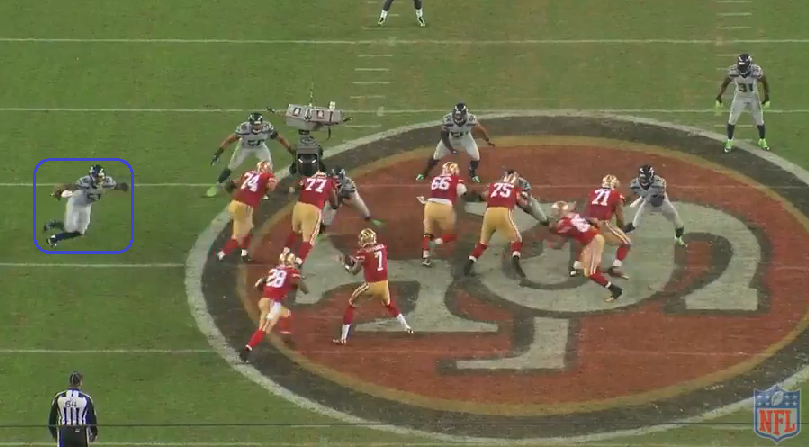
Strongside zone blocking provides an area to read for a possible run lane. Kickout block provides a cutback lane should the RB choose to use it.
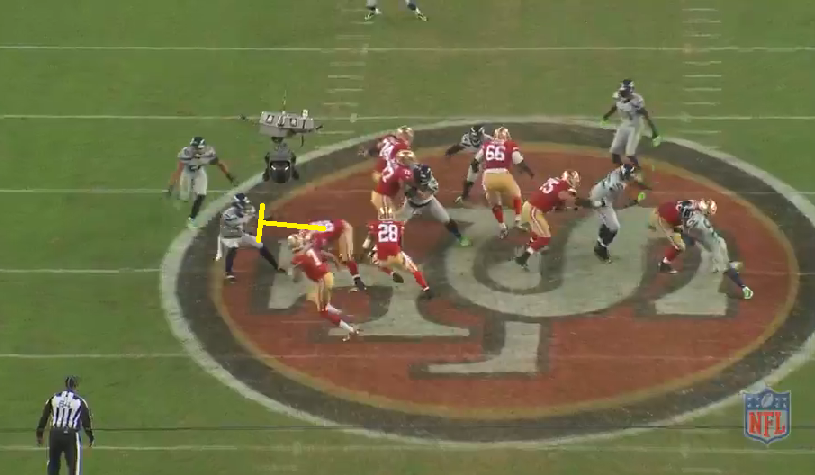
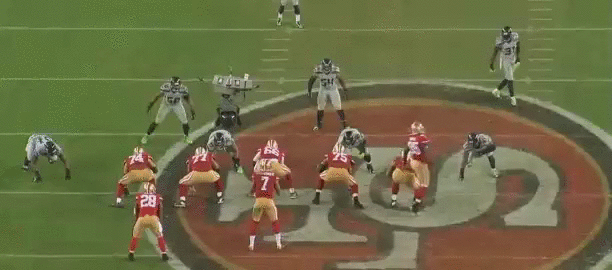
- Zone step towards the strong side of the formation
- TE/FB comes across the formation to kickout block the backside cut defender.
'Covered' OLmen's blocks are black. Kickout block is yellow.

Uncovered OLmen move to second level as TE comes across the formation, opposite the flow of the OLmen.

Strongside zone blocking provides an area to read for a possible run lane. Kickout block provides a cutback lane should the RB choose to use it.


May 27, 2015 at 3:17 PM
- thl408
- Moderator
- Posts: 32,361
Zone Lead - Zone Blocking
- Inside zone blocking
- FB lead into playside A gap
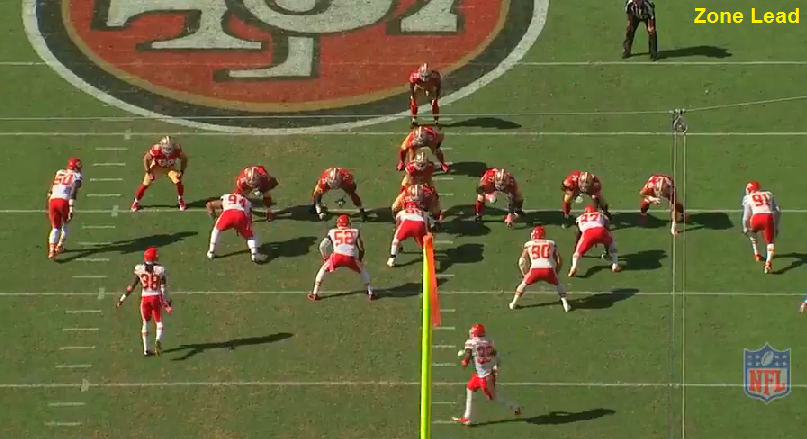
Zone step right (from OL perspective)
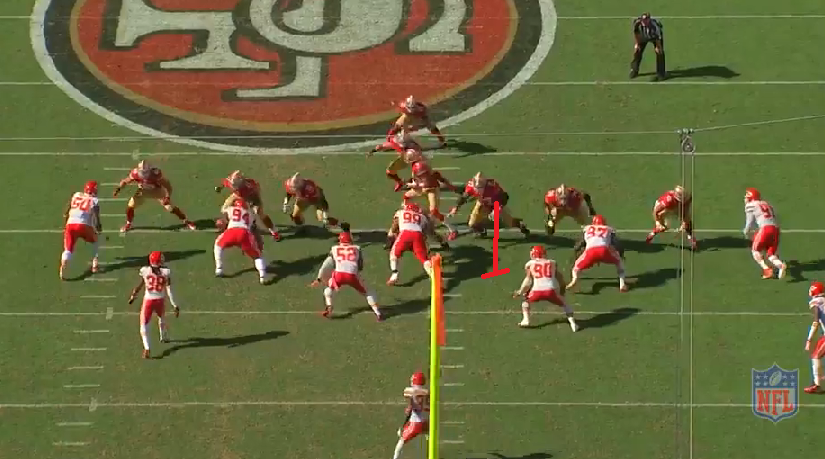
FB into the playside A gap.
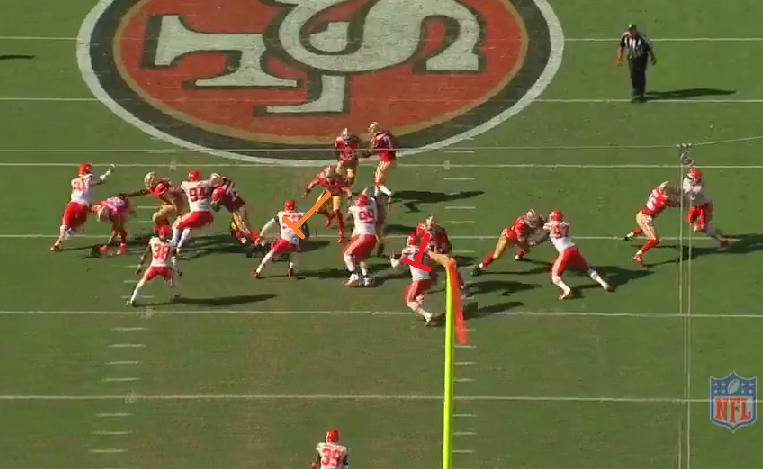
RB reads the blocks.
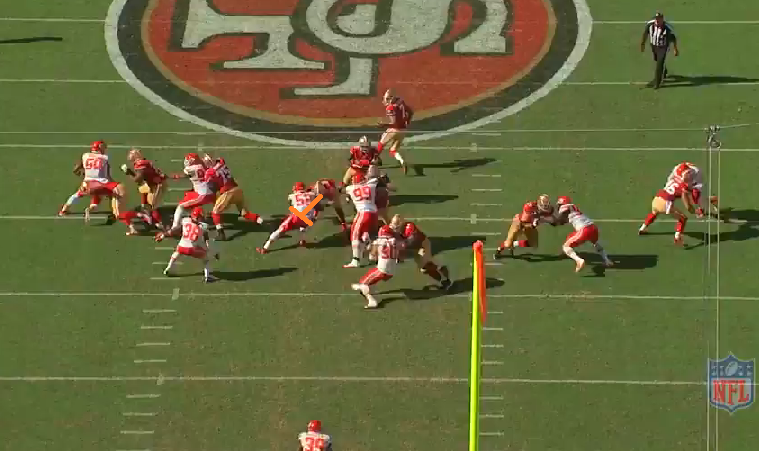
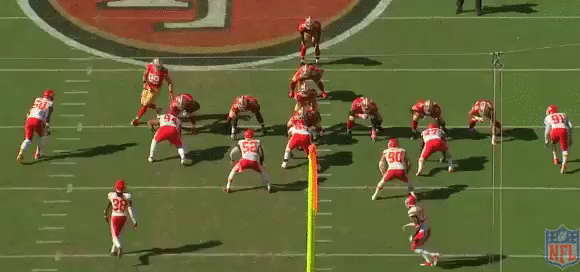
- Inside zone blocking
- FB lead into playside A gap

Zone step right (from OL perspective)

FB into the playside A gap.

RB reads the blocks.


May 27, 2015 at 3:18 PM
- thl408
- Moderator
- Posts: 32,361
Zone Read - Zone Blocking
Traditional run plays with the QB handing off to the RB result in the defense not having to take account for the QB. The QB is neither a run threat or a blocker, and does not factor into the numbers game when counting offensive blockers versus box defenders.
The Zone Read play forces the defense to take account for the QB as a threat. This gives a +1 to the count of offensive blockers when compared to a traditional run play because the Zone Read allows a defender to be completely unblocked.
- OL blocks for zone blocking run play
- QB reads the unblocked key defender, the end man on the line of scrimmage, to determine whether to keep the ball or handoff to the RB
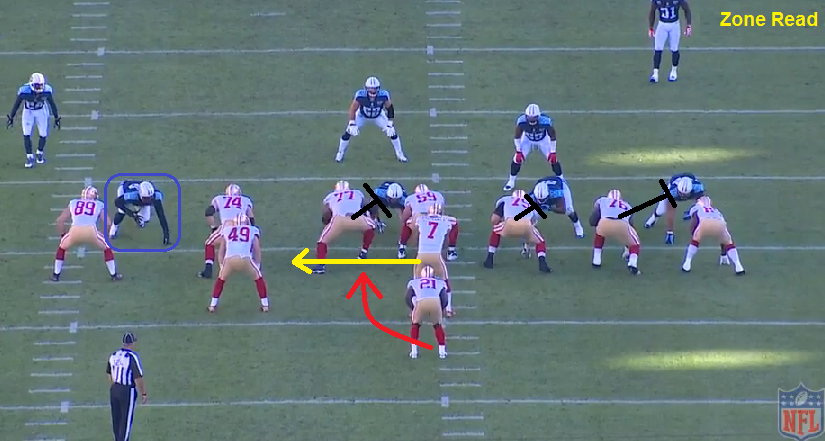
OLine zone steps to the right. Uncovered OL move to second level.
While at the 'mesh point', the QB reads the unblocked key defender, who crashes down towards the RB dive. The correct decision is to keep the ball. The LT has no one to block because of the number advantage to the offense.
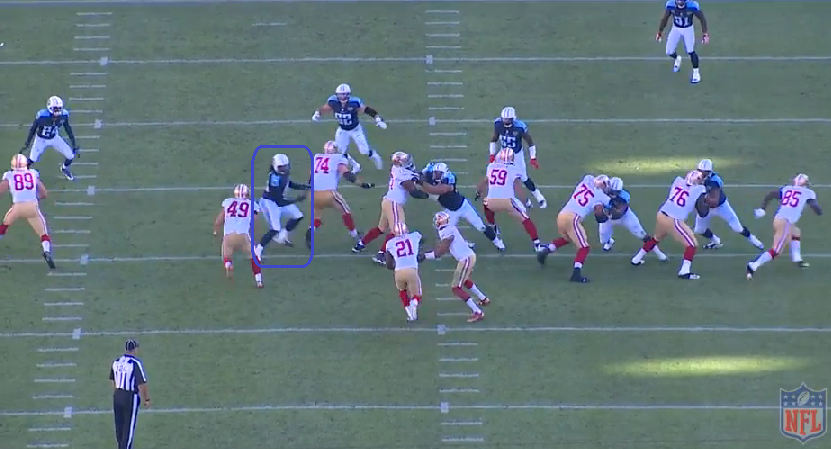

______________________________________
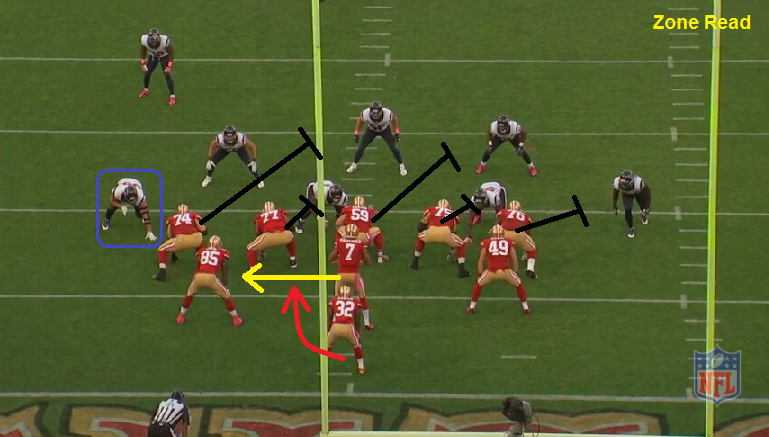
Zone step to the right. Unengaged/uncovered blockers move to second level. Key defender does not crash down on the RB dive. The correct decision is to hand off for the RB dive. The numbers advantage results in the FB being 5 yards downfield before a block is identified.
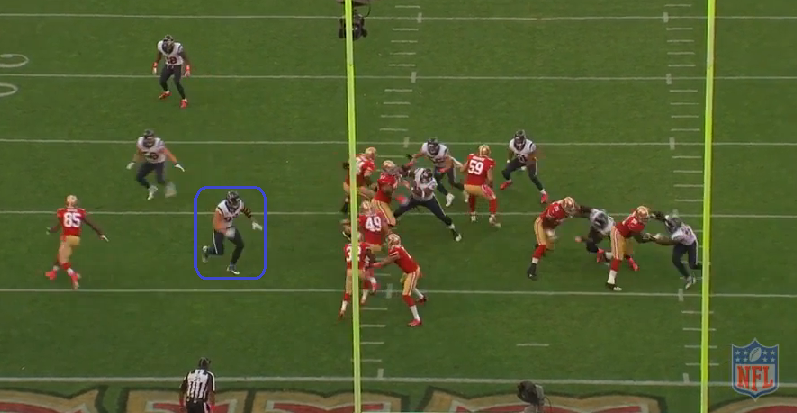
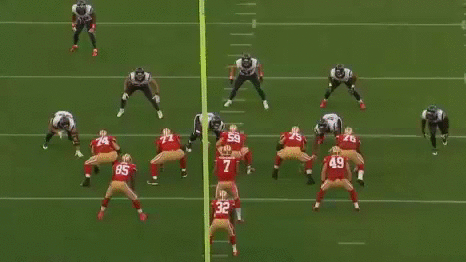
Traditional run plays with the QB handing off to the RB result in the defense not having to take account for the QB. The QB is neither a run threat or a blocker, and does not factor into the numbers game when counting offensive blockers versus box defenders.
The Zone Read play forces the defense to take account for the QB as a threat. This gives a +1 to the count of offensive blockers when compared to a traditional run play because the Zone Read allows a defender to be completely unblocked.
- OL blocks for zone blocking run play
- QB reads the unblocked key defender, the end man on the line of scrimmage, to determine whether to keep the ball or handoff to the RB

OLine zone steps to the right. Uncovered OL move to second level.
While at the 'mesh point', the QB reads the unblocked key defender, who crashes down towards the RB dive. The correct decision is to keep the ball. The LT has no one to block because of the number advantage to the offense.


______________________________________

Zone step to the right. Unengaged/uncovered blockers move to second level. Key defender does not crash down on the RB dive. The correct decision is to hand off for the RB dive. The numbers advantage results in the FB being 5 yards downfield before a block is identified.


May 27, 2015 at 3:18 PM
- thl408
- Moderator
- Posts: 32,361
.